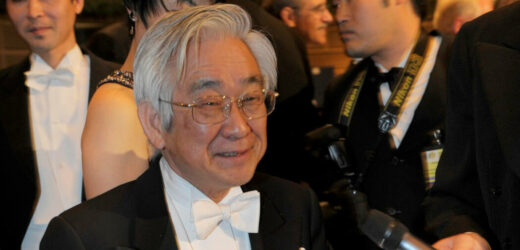Toshihide Maskawa, a theoretical physicist who was awarded the Nobel Prize for correctly predicting the existence of three families of fundamental particles called quarks, which helped explain one of the most important phenomena in nature and one of the enduring mysteries of the universe — how it is that we even exist — died on July 23 in Kyoto, Japan. He was 81.
The Nobel Foundation in Stockholm confirmed his death. Japanese news outlets said the cause was a cancer of the mouth.
Aristotle was reported to have said that nature abhors a vacuum. A similar observation can be made about physicists: They abhor asymmetry.
In general, physicists look for symmetry in nature. “It’s the lamppost that we search under,” as Michael S. Turner, a cosmologist at the University of Chicago, has said.
But like the six points of a snowflake that are supposed to be symmetrical but rarely are, it turns out that there are notable exceptions to symmetry in the universe. They’re called broken symmetries, and Dr. Maskawa delved into understanding one of the most important ones, called CP violation.
According to the most widely accepted theory of the origin of the universe, the so-called Big Bang, an equal amount of matter and antimatter should have been present at the creation. And since these two cancel each other out when combined, the universe should have been very short-lived.
Fortunately, there is more matter in the universe — by a small but meaningful amount — than antimatter, and the reason for that phenomenon seems to be CP violation. (The C stands for charge, like the negative charge of an electron; the P stands for parity, or what’s also known as handedness, as in right- and left-handed.)
Before CP violation was discovered, scientists had assumed that exchanging positive for negative and left-handed for right-handed in the equations of elementary particles would produce the same result. But in 1964 James W. Cronin and Val L. Fitch, while working with particles called kaons, or K mesons, found that while kaons can transform into their antiparticles, so that the parity and charge are reversed, the opposite transformation, from kaon antiparticle to particle, does not happen as often. The discovery of CP violation led to the 1980 Nobel Prize for Dr. Cronin and Dr. Fitch.
What stumped physicists was what caused this to happen. Dr. Maskawa and a collaborator, Makoto Kobayashi, succeeded in explaining it, building on another breakthrough in 1964: the hypothesis that there was an as-yet undiscovered class of fundamental particles called quarks.
Proposed by Murray Gell-Mann and George Zweig, quarks were said to be the constituents of the protons and neutrons that make up the nuclei of atoms. (Dr. Gell-Mann named the particles after a line in James Joyce’s “Finnegans Wake”: “Three quarks for Muster Mark!”) In 1968, experiments at the Stanford Linear Accelerator Center in California proved that quarks existed.
Initially, three types of quarks were found, named “up,” “down” and “strange.” A fourth was discovered in 1974 and called “charmed” (proof positive that physicists can have quirky senses of humor).
Dr. Maskawa and Dr. Kobayashi began trying to explain the cause of CP violation in 1972, when they were at Kyoto University. Basing part of their research on a mathematical model of particle decay by Nicola Cabibbo, an Italian physicist, they developed a theoretical matrix using four types of quarks.
One night, as Dr. Maskawa recalled in his Nobel lecture, he was taking a bath when he had a eureka moment. He had been unable to crack the CP violation problem using his four-quark model and had all but given up hope of doing so. But as he was getting out of the bath, he suddenly realized that if there were six quarks instead of four it would it be possible for the up, down and strange quarks to switch back and forth, changing some kaons into their antiparticles. The existence of six types of quarks, it occurred to him, would allow for CP violation.
He and Dr. Kobayashi set about proposing a new, six-quark matrix, now known as CKM (named after Dr. Cabibbo, Dr. Kobayashi and Dr. Maskawa), and they published the result in a landmark 1973 paper, “CP-Violation in the Renormalizable Theory of Weak Interaction,” which remains among the most cited in high-energy physics.
Four years later, they were proved right when the fifth type of quark, called the “bottom,” was discovered. The last type of quark, the “top,” was found in 1995.
Together, the six quarks are divided into three families (up and down; charm and strange; and top and bottom) and are now an essential part of the Standard Model, which classifies all known fundamental particles in the universe and is one of the crowning achievements of physics in the 20th century.
Dr. Maskawa and Dr. Kobayashi were awarded half the Nobel Prize in 2008 for “the discovery of the origin of the broken symmetry which predicts the existence of at least three families of quarks in nature.” The other half went to Dr. Yoichiro Nambu, a Japanese-born American, for “the discovery of the mechanism of spontaneous broken symmetry in subatomic physics.”
(Dr. Cabibbo, though his work was seen as essential to that of Dr. Maskawa and Dr. Kobayashi’s discovery, was not recognized for the Nobel, an omission that drew complaints from Italian physicists. The prize, by design, recognizes only three recipients in a category in any given year.)
Toshihide Maskawa was born on Feb. 7, 1940, in Nagoya, Japan, the second of three children, and only son, of Ichiro and Kaneko (Nojima) Maskawa. (His future research collaborator, Dr. Kobayashi, was also born in Nagoya, four years later.) Toshihide’s older sister died of tuberculosis when she was young.
His father owned a small furniture-making business, but his real interest was engineering and science. Lacking a formal education, he learned what he could on his own and passed his passion along to his son.
Dr. Maskawa had a near-death experience during World War II, when he was 5.
One night in 1945, an American incendiary bomb fell on his house in Nagoya, breaking through the roof without exploding and coming to rest near where he sat on an earthen floor. Surrounding houses and his father’s furniture business were destroyed by flames from other bombs. His family escaped by piling what possessions they could on a cart and fleeing on foot.
After the war, Dr. Maskawa recalled, his parents became sugar merchants, working from home from morning to night and having little time to pay attention to their son. Toshihide preferred play to doing schoolwork, but that caught up with him one day when his mother asked his teacher to please assign him some homework. The teacher replied that he did, every day, but that Toshihide never did it.
He continued to be an indifferent student through most of high school, but two things changed his course. One was that he liked to read, and when he came across some math books one day, he found them fascinating. He also found he had a talent for math, and began working out problems on his own.
The second life-changing moment was his learning in a newspaper that a renowned particle physicist, Shoichi Sakata, was a professor in his city at Nagoya University. The realization that important scientific work could be done in the place where he was born opened Toshihide’s eyes to new possibilities.
His father had wanted him to follow him into the sugar business, but the son now wanted to become a mathematician or a scientist. He began studying, gained entrance to Nagoya University and graduated in 1962. He remained at Nagoya to obtain his doctorate in 1967, with Dr. Sakata as his thesis adviser, then worked with Dr. Sakata as a research assistant until 1970.
He went on to hold professorships at Kyoto University, Tokyo University and the Yukawa Institute of Theoretical Physics in Kyoto, where he was also director from 1997 to 2003, when he became an emeritus professor at Kyoto University.
Nagoya University hired Dr. Maskawa as a distinguished professor in 2009. A year later, the university founded the Kobayashi-Maskawa Institute for the Origin of Particles and the Universe. He retired as its director in 2018.
Dr. Maskawa married Akiko Takahasi in 1967, and they had two children, Kazuki and Tokifumi. Information on his survivors was not available.
In 1985, Dr. Maskawa and Dr. Kobayashi received the inaugural J.J. Sakurai Prize, which is widely considered the most important prize in particle physics outside of the Nobel.
Strongly opposed to war, Dr. Maskawa co-founded the Article 9 Association of Scientists in 2005. The group takes its name from a part of the Japanese postwar constitution that outlaws offensive military action as a way for Japan to settle international disputes. Dr. Maskawa and his colleagues hoped to persuade other countries to follow suit.
His antiwar stance made him sympathetic to all victims of conflict and sometimes put him at odds with his own government, which was often reluctant to acknowledge what the country had done during World War II.
“I have always said that Japan indeed suffered grave damage in the war, but Japan wrought the same sort of destruction in China, Korea and the nations of Southeast Asia,” he told Chugoku Shimbun, a Hiroshima daily newspaper, in 2011. “I believe that people who refuse to acknowledge this reality are not entitled to speak out about peace issues.”
Source: Read Full Article


